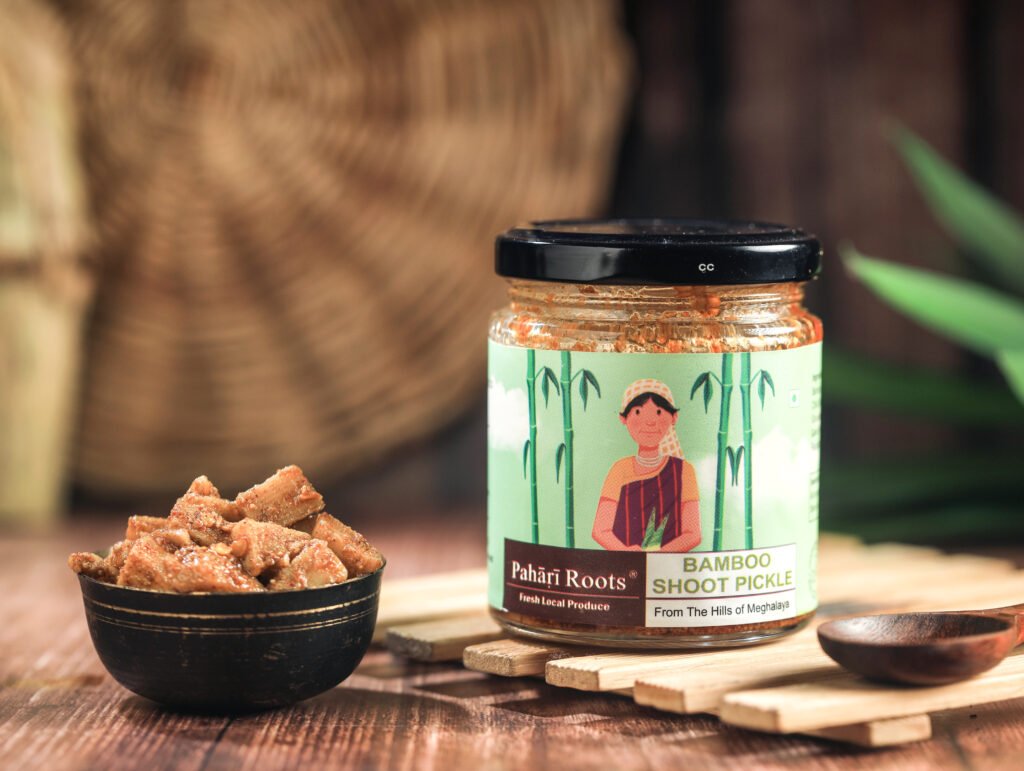
Executive Summary
Pahari Roots’ Bamboo Shoot Pickle is prepared using freshly fermented young bamboo shoots harvested from the forests and homestead groves of Meghalaya. Sourced directly from local women-led foragers and processors, the shoots are collected during the rainy season, fermented naturally using traditional Khasi methods, and pickled with oil, spices, and salt. Made without preservatives or additives, the pickle is packed in Mumbai under strict FSSAI compliance. This product supports rural women, preserves cultural food practices, and delivers an authentic, regionally rooted flavour.
Product Profile
Region: Meghalaya (Khasi and Jaintia Hills)
Altitude: 800–1,500 m
Climate: High rainfall (2,000–3,500 mm); 18–26 °C
Harvest Season: June–September (monsoon)
Species Used: Dendrocalamus hamiltonii, Bambusa spp.
Processing: Fermented shoots, blended with mustard oil and spices
Shelf Life: 9–12 months (sealed); refrigerate after opening
Texture & Taste: Sour, umami-rich, with a tangy fermented bite
Harvesting & Preparation
Young bamboo shoots are harvested manually during monsoon, peeled, sliced, and fermented in natural brine for 5–10 days before pickling.
Challenges
- Season-dependent availability
- Fermentation quality varies by ambient humidity and temperature
- Small-scale processing limits batch consistency
- Traditional methods not always aligned with food safety awareness
Post-Harvest & Processing
- Shoots are naturally fermented (no vinegar or artificial agents)
- Mixed with mustard oil, chili, turmeric, and salt
- Packed in food-grade PET/glass jars
- Lab-tested for moisture, pH, microbial stability, and shelf life
Regional Difference
Unlike mass-produced pickles, this uses region-specific fermentation and heirloom bamboo species. The process gives it a distinct aroma and umami depth.
Sourcing & Logistics
Sourced from women-led community groups in Meghalaya; transported by road to Mumbai for cleaning, batch testing, and hygienic bottling.
Compliance
FSSAI-certified; batch-wise tested for acidity, microbial load, and oil quality. Free from synthetic preservatives and colours.
Sustainability & Impact
- Supports traditional food skills and seasonal income
- Provides rural women with stable market access
- Encourages non-timber forest produce utilization sustainably
Customer Story
Crafted from tender bamboo shoots foraged during the monsoon and fermented the traditional Khasi way, this pickle is a tribute to Northeast India’s culinary heritage. Local women clean, slice, and preserve the shoots using time-tested methods—then blend them with mustard oil and spices to create a tangy, bold flavour. We bring it to Mumbai, where it’s bottled and lab-verified for quality. Every jar supports livelihoods, preserves regional identity, and adds a wild, flavorful kick to your plate.
FAQs (short)
Where is it sourced? Forests and groves in Meghalaya
When is it harvested? June to September
Who makes it? Women-led local processors
Is it fermented? Yes, naturally without vinegar
What makes it special? Tangy, umami flavour from wild bamboo
Any preservatives? No; oil and salt act as natural preservatives
How is it processed? Fermented, spiced, and bottled
How is safety ensured? Lab-tested for microbial stability and pH
How long does it last? 9–12 months (sealed)
Impact? Supports rural women and traditional food culture
Executive Summary
Pahari Roots Wild Forest Honey is collected from natural hives in the deep forested areas of Meghalaya, where indigenous communities practice sustainable, seasonal foraging. Sourced from altitudes ranging between 600–1,400 m, this raw, unprocessed honey comes from wild bees (Apis dorsata and Apis cerana) feeding on diverse forest flora. Harvested by hand during peak flowering months (March–June, October–December), it is filtered without heating to retain nutrients. The honey is transported to Mumbai for lab testing and hygienic, FSSAI-compliant bottling. Direct sourcing supports forest conservation and rural incomes.
Product Profile
Region: Meghalaya (forest belts in Khasi and Garo Hills)
Altitude: 600–1,400 m
Flora: Wild forest blooms, herbs, and medicinal plants
Climate: 2,000–3,500 mm rainfall; 16–27 °C
Harvest Season: March–June and Oct–Dec
Bee Species: Apis dorsata (giant bee), Apis cerana indica
Texture & Taste: Thick, dark amber; woody, floral, mildly smoky
Processing: Raw, unheated, gravity-filtered only
Harvesting & Collection
Collected manually from cliff-side and tree-top hives by local foragers using traditional methods. Harvesting is done seasonally and selectively to protect colonies.
Challenges
- Remote terrain and difficult access
- Harvest depends on natural cycles and weather
- High risk due to wild bee handling
- Limited awareness of hygiene and filtration standards
Post-Harvest & Processing
- Collected in clean containers and coarse-filtered
- No boiling, heating, or chemical processing
- Lab-tested in Mumbai for purity, moisture (<20%), sugar profile, and contaminants
- Bottled and labelled under FSSAI norms
Regional Difference
Compared to farmed honey, Meghalaya’s wild honey has richer antioxidant and micronutrient content due to varied forest nectar sources and non-industrial handling.
Sourcing & Logistics
Sourced directly from tribal foraging groups; transported by road to Mumbai. Seasonal delays possible due to monsoon and remote locations.
Compliance
FSSAI-certified; tested for moisture, HMF, sugar profile, and absence of antibiotics. Traceable by batch and packed in food-grade bottles.
Sustainability & Impact
- Supports tribal livelihoods and cultural knowledge
- Encourages non-destructive, seasonal harvesting
- Promotes biodiversity and forest conservation
Customer Story
Harvested by indigenous communities deep in Meghalaya’s forests, this wild honey is raw, rich, and untouched by industrial methods. Local foragers scale cliffs and trees during bloom season, collecting only what the bees can spare. No heating, no refining—just coarse filtering and care. Once transported to Mumbai, we test each batch and bottle it safely. By choosing this honey, you support traditional knowledge, forest health, and the purest form of sweetness from the wild.
FAQs (short)
Where is it collected? Forests in Meghalaya’s Khasi and Garo Hills
When is it harvested? March–June, October–December
Who collects it? Local foragers and tribal communities
What makes it special? Raw, unheated, forest-sourced
How is it processed? Gravity-filtered, no heat or additives
What flowers is it from? Wild forest and medicinal flora
How is quality ensured? Lab-tested for purity and safety
Is it organic? Collected from wild, unsprayed ecosystems
How is it packed? Food-grade, FSSAI-compliant bottles
Impact? Supports rural incomes and forest preservation

